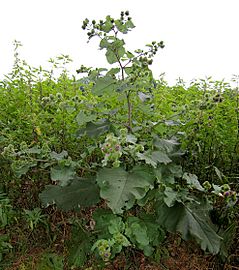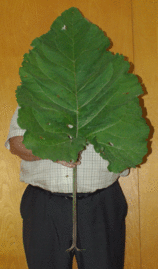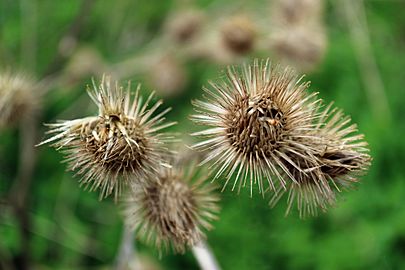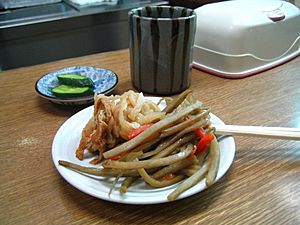Burdock facts for kids
Quick facts for kids Burdock |
|
|---|---|
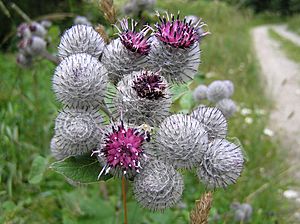 |
|
| Arctium tomentosum | |
| Scientific classification |
|
| Kingdom: | Plantae |
| Clade: | Tracheophytes |
| Clade: | Angiosperms |
| Clade: | Eudicots |
| Clade: | Asterids |
| Order: | Asterales |
| Family: | Asteraceae |
| Subfamily: | Carduoideae |
| Tribe: | Cardueae |
| Subtribe: | Arctiinae |
| Genus: | Arctium L. 1753 not Lam. 1779 |
| Synonyms | |
|
|
Arctium is a group of plants commonly known as burdock. These plants live for two years and belong to the Asteraceae family, which includes daisies. Burdock originally comes from Europe and Asia, but you can now find different types of burdock in many parts of the world.
One cool thing about burdock is how its seeds stick to things. This amazing sticking power helps the plant spread its seeds. It even inspired the invention of hook and loop fasteners, like Velcro!
Contents
About Burdock Plants
Burdock plants have dark green leaves that can grow up to 70 centimeters (about 27 inches) long. The leaves are usually big, rough, and oval-shaped. The ones closer to the ground are often heart-shaped and feel fuzzy on the underside. The stems that hold the leaves are usually hollow.
Burdock plants typically bloom from July to October. Their flowers are very important for honeybees. In August, when other flowers like clover start to fade, burdock flowers provide lots of pollen and nectar for bees. This helps bees get ready for winter before other plants like goldenrod start to bloom.
Burdock's sticky burrs are great for spreading its seeds. They easily attach to animal fur or people's clothes, helping the seeds travel to new places.
-
Arctium lappa (greater burdock)
Burdock's Family Tree
Many different plants have been called Arctium over time. However, most of them are now placed in a related plant group called Cousinia. It's a bit tricky to tell the exact difference between Arctium and Cousinia because they are very closely related.
Sometimes, burdock plants are confused with other plants like cockleburs (from the Xanthium group) or rhubarb (from the Rheum group).
Types of Burdock
Here are some of the accepted types of burdock plants:
- Arctium abolinii
- Arctium alberti
- Arctium × ambiguum
- Arctium amplissimum
- Arctium anomalum
- Arctium arctiodes
- Arctium atlanticum – Found in Algeria and Morocco
- Arctium aureum
- Arctium chloranthum
- Arctium dolichophyllum
- Arctium × dualis
- Arctium echinopifolium
- Arctium egregium
- Arctium elatum
- Arctium evidens
- Arctium fedtschenkoanum
- Arctium grandifolium
- Arctium haesitabundum
- Arctium horrescens
- Arctium karatavicum
- Arctium korolkowii
- Arctium korshinskyi
- Arctium lappa – Also known as greater burdock. It grows naturally in much of Europe and Asia, and has spread to North America, Australia, and New Zealand.
- Arctium lappaceum
- Arctium × leiobardanum – Found in Siberia
- Arctium leiospermum
- Arctium × maassii
- Arctium macilentum
- Arctium medians
- Arctium minus – Also known as lesser burdock. It grows naturally in Europe and southwestern Asia, and has spread to North and South America, Australia, and New Zealand.
- Arctium × mixtum
- Arctium nemorosum
- Arctium nidulans
- Arctium × nothum – Found in central and eastern Europe
- Arctium palladinii – Found in Turkey, Iran, and the Caucasus region
- Arctium pallidivirens
- Arctium pentacanthoides
- Arctium pentacanthum
- Arctium pseudarctium – Found in Afghanistan and Tajikistan
- Arctium pterolepidum
- Arctium radula
- Arctium refractum
- Arctium sardaimionense – Found in Tajikistan
- Arctium schmalhausenii
- Arctium × semiconstrictum
- Arctium tomentellum
- Arctium tomentosum – Also known as woolly burdock. It grows naturally in northern and eastern Europe, Turkey, Iran, the Caucasus, Siberia, and Xinjiang. It has also spread to North America.
- Arctium triflorum
- Arctium ugamense
- Arctium umbrosum
- Arctium vavilovii
- Arctium × zalewskii
Where the Name Comes From
The word "burdock" came about around the 1500s. It combines "bur" (for the sticky seed heads) and "dock," which was a name for plants like sorrel.
Burdock in Nature
The roots of burdock plants are a food source for the larvae (young forms) of certain moths, like the ghost moth. Other moths and butterflies also eat burdock, including the brown-tail moth and the Gothic moth.
The prickly seed heads, called burrs, are famous for sticking easily to fur and clothing. In England, some people who watch birds have seen birds get tangled in these burrs. Sadly, the birds can't free themselves and might die.
Is Burdock Safe?
The green parts of the burdock plant that grow above ground can sometimes cause a skin rash (called contact dermatitis) in people who are allergic to certain substances called lactones found in the plant.
How People Use Burdock
Food and Drinks
The long main root (called a taproot) of young burdock plants can be harvested and eaten as a root vegetable. While it's not very common in European cooking today, it's very popular in East Asia.
In Chinese, Arctium lappa is called niúbàng. This name was borrowed into Japanese as gobō. It's eaten in Japan, Korea, and Taiwan. In Korean, burdock root is called u-eong.
Farmers grow burdock for its long, thin roots, which can be about one meter (3 feet) long and two centimeters (less than an inch) wide. Burdock root is very crunchy and has a sweet, mild, or strong flavor. It can sometimes taste a bit earthy, but you can reduce this by soaking the shredded roots in water for 5 to 10 minutes. In Russia, burdock roots have even been used instead of potatoes.
You can also harvest the young flower stalks in late spring before the flowers appear. They taste a bit like artichokes, which are related to burdock. These stalks are peeled carefully and can be eaten raw or boiled in salty water. In Japan, young, soft burdock leaves are also eaten in the spring.
A popular Japanese dish is kinpira gobō. This is made from shredded burdock root and carrot, cooked in a sauce with soy sauce, sugar, and sesame oil. Another dish is burdock makizushi, which is sushi filled with pickled burdock root. The burdock root is often colored orange to look like a carrot.
In the second half of the 1900s, burdock became known around the world for cooking. This was partly because of the growing popularity of the macrobiotic diet, which suggests eating burdock. Burdock root has a good amount of dietary fiber (about 6 grams per 100 grams), calcium, potassium, and amino acids. It's also low in calories. It contains a special fiber called inulin, which is good for your gut.
Burdock root's earthy taste goes well with pork in miso soup (called tonjiru) and with Japanese-style pilaf (called takikomi gohan).
Dandelion and burdock is a popular soft drink in the United Kingdom. It started as a type of mead (a drink made from honey) that was common in the Middle Ages.
In Europe, burdock root was used to make beer taste bitter before people started using hops for that purpose.
Traditional Medicine
The seeds of A. lappa are used in traditional Chinese medicine and are called niubangzi.
Burdock is also a traditional medicinal herb used for various health issues. Burdock root oil extract, also known as bur oil, is used in Europe as a treatment for the scalp.
Burdock in Culture
The Russian author Leo Tolstoy wrote in his journal in 1896 about a tiny burdock shoot he saw in a plowed field. He said it was "Black from dust but still alive and red in the center. It reminded me of Hadji Murad. It makes me want to write. It asserts life to the end, and alone in the midst of the whole field, somehow or other had asserted it." This shows how even a small burdock plant can symbolize strength and life.
In Turkish Anatolia, people believed the burdock plant could protect against the evil eye. Because of this, you often see burdock patterns woven into kilims (rugs) for protection. With its many flowers, the plant also stands for lots of good things and plenty.
Before and during World War II, Japanese soldiers carried a type of bayonet (a knife attached to a rifle) called the juken. Its nickname was the "burdock sword" (gobo ken).
Inspiration for Velcro
In the late 1940s (around 1948), a Swiss inventor named George de Mestral went for a walk with his dog. He noticed how burdock seeds stuck to his clothes and his dog's fur. He became curious and looked at the seeds under a microscope. He saw the tiny hook system that the seeds use to attach to passing animals, which helps them spread.
De Mestral realized that this same idea could be used to join other things together. His discovery led to the creation of the hook and loop fastener, which was first sold under the famous Velcro brand name.
Many languages use the same word for both burdock and Velcro. For example, in Serbo-Croatian, čičak means both. In Polish, rzep means "burr" and "Velcro." The German word for burdock is Klette, and Velcro is Klettverschluss (which means "burdock fastener"). In Norwegian, burdock is borre and Velcro is borrelås ("burdock lock").
Images for kids
-
A dish containing a Japanese appetizer, kinpira gobō, consisting of sautéed burdock root and carrot, with a side of sautéed dried daikon
See also
 In Spanish: Arctium para niños
In Spanish: Arctium para niños


